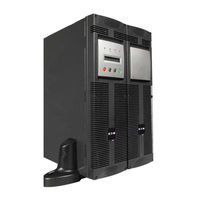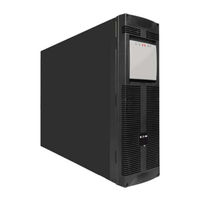Eaton EX RT EXB 11 Power Supply Manuals
Manuals and User Guides for Eaton EX RT EXB 11 Power Supply. We have 3 Eaton EX RT EXB 11 Power Supply manuals available for free PDF download: Installation And User Manual, Quick Start Manual
Eaton EX RT EXB 11 Installation And User Manual (233 pages)
Table of Contents
-
Options10
-
Installation14
-
Power Module14
-
Hot Standby22
-
Operation29
-
Eco Mode31
-
Shut down33
-
Maintenance34
-
Appendices38
-
Glossary41
-
Appendices41
-
Présentation46
-
Options48
-
Installation52
-
Utilisation67
-
Mode Eco69
-
Maintenance72
-
Anomalies72
-
Annexes76
-
Glossaire79
-
Index79
-
Tower-Modell84
-
Rack-Modell84
-
Optionen86
-
USV-Modul90
-
Betriebszustände105
-
Betriebsarten107
-
ECO-Mode107
-
Batteriebetrieb108
-
Tower-Modell111
-
Schulungszentrum113
-
Anhang114
-
Fachbegriffe117
-
Presentazione122
-
Posizione "Tower122
-
Posizione "Slot122
-
Parti Posteriori123
-
Opzioni124
-
Installazione128
-
Modulo Batteria128
-
Modalità Eco145
-
Arresto Dell'ups147
-
Allegati152
-
Glossario155
-
Indice Analitico155
-
Presentación160
-
Posición Rack160
-
Caras Traseras161
-
Opciones162
-
Instalación166
-
Utilización181
-
Modo Eco183
-
Cambio a Batería184
-
Parada del SAI185
-
Mantenimiento186
-
Anomalías186
-
Anexos190
-
Glosario193
-
Indice193
-
Beschrijving198
-
Rack-Opstelling198
-
Achterpanelen199
-
Opties200
-
Installeren204
-
Power Module204
-
Batterijmodule204
-
Tower-Opstelling205
-
Rack-Opstelling206
-
Noodstop210
-
Gebruik219
-
Bedrijfsmodes221
-
Eco-Mode221
-
Onderhoud224
-
Storingen224
-
Opleidingscentra227
-
Bijlagen228
-
Woordenlijst231
-
Index231
Advertisement
Eaton EX RT EXB 11 Installation And User Manual (38 pages)
Table of Contents
-
-
Options7
-
-
-
Power Module11
-
-
-
3 Operation
26-
Shut down30
-
5 Appendices
35
Eaton EX RT EXB 11 Quick Start Manual (9 pages)
Battery Module
Brand: Eaton
|
Category: Camera Accessories
|
Size: 0 MB
Table of Contents
Advertisement


